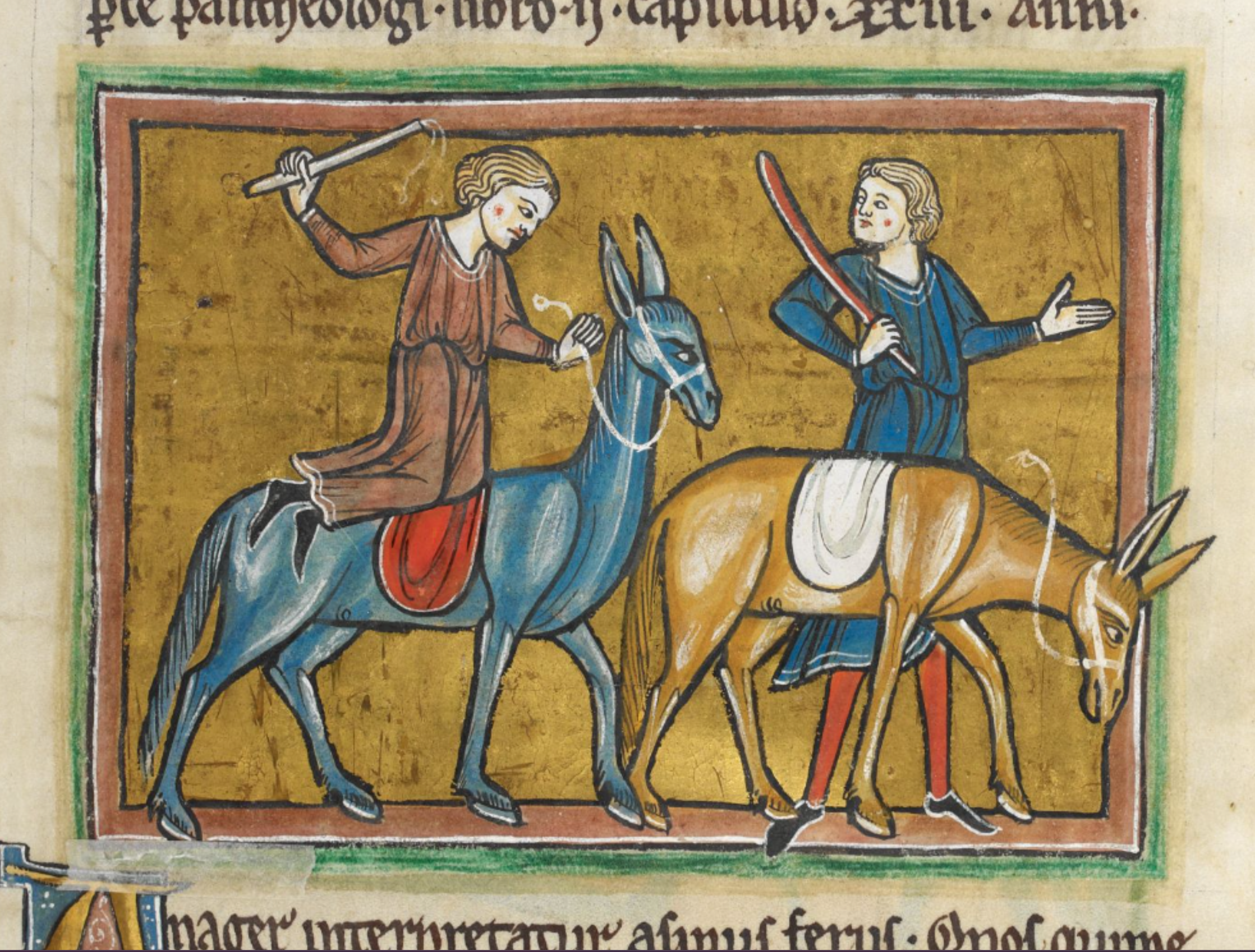Ass, Rochester Bestiary, c.1230
In the Middle Ages, the ass has mainly negative connotations.
On one hand, it was symbolic of humility due to its humble nature and its role in serving humans, such as carrying burdens or being used for transportation. This humility was often contrasted with the prideful nature of other animals.
On the other hand, the ass could also symbolize stubbornness and ignorance, particularly when it resisted direction or refused to learn. This interpretation was often used to caution against the dangers of arrogance and obstinacy.
As a beast of burden, the ass symbolized servitude and endurance, representing the virtues of patience and perseverance in the face of hardship. This aspect of the ass's symbolism aligned with Christian teachings on the value of humility and service to others.
Due to the size of its sexual organs, the ass was associated to lewdness and embodied sexual pleasure, which was condemned by the Church. It represented the contrast between carnal and spiritual man, Christians and Pagans as well the educated and the ignoramuses.
In Christian theology, the ass is sometimes associated with specific events in the life of Jesus Christ. For example, the Gospel of Matthew recounts Jesus's entry into Jerusalem riding on a donkey (ass) on Palm Sunday, which was seen as fulfilling a prophecy from the Old Testament (Zechariah 9:9)1. This event symbolized humility, peace, and the arrival of the Messiah.
hoc nomen quod magis equis convenit. ideo hoc
animal sumpsit; quia priusquam equos caperent ho-
mines; huic insidere ceperunt. Animal quippe tar-
dum. et nulla ratione renitens. Statim ut voluerit
sibi homo subtrahit. Asinos arcadicos dictos. eoquod ab
arcadia primum vectisunt. magni et alti. Minor autem
asellus onagro; plus necessarius est. qui et laborem tolerat;
The words ăsĭnus for ass and ăsellus for donkey come from sĕdendo (sitting), and sounds as if the word were asedus but this name is more suitable for horses. Therefore, this animal took this name, for humans began to sit on this creature, prior to utilizing horses. Indeed, it is a slow-moving animal by nature and offers no resistance in any way; therefore, men used to bend it to their will as they pleased. The Arcadian donkeys are called so, for they were first used in Arcadia3. They are large and tall.
However, the smaller donkey is called ŏnăgrus4, onager or wild ass; it is a more useful beast, for it tolerates labour
Asini sive asine nomine; aliquando dicitur gentilis po-
pulus. aliquando iudaicus populus. aliquando infidelis. ali-
quando simplices et idiote honera ecclesie portan-
tes. aliquando stultus et hebes. et luxuriosus et carna-
lis. et sensualis. aliquando stulta sensualitas. et irra-
tionabilis motus carnis. aliquando sancta anima. aliquando
pacientia predicatorum. Que omnia patent in .iiiita.
parte pantheologi. libro .iio. capitulo. xxiii. Asini.
and does not withdraw therefrom. The words ăsĭni or ăsĭnae are also used to refer sometimes to the pagans, sometimes to the Jews, sometimes to infidels, sometimes to simple people carrying the burdens of the church. Sometimes, they refer to foolish and half-witted people, and sometimes to someone indulging in luxury and carnal pleasures. They also denote foolish sensuality and irrational passions of the flesh. Other times, they represent the holy soul, patience of preachers, and all these are explained in the third part of the Pantheology5, Book 2, Chapter 23 on donkeys.
Bibliography
David Badke, The Bestiary Blog: Animals in the Middle Ages, Ass, November 6 2023, https://bestiary.ca/beasts/beast210.htm
Josh Goldenberg (BA 2012) and Matt Shanahan (BA 2014), Logeion, November 2022, https://logeion.uchicago.edu/
Castiglioni, L. and Mariotti, S. (1996). Vocabolario della Lingua Latina: Latino-Italiano Italiano-Latino. Terza Edizione. Loescher Torino
Matthews, J. and Matthews C., (2010), The Element Encyclopedia of Magical Creatures, HarperCollins UK, London
Curley, M. J., Physiologus: A Medieval Book of Nature Lore (University of Chicago edition 2009)
Rackham, H., M.A., Pliny Natural History Volume III, Libri VIII-XI (London: William Heinemann Ltd, 1949)
Collins, A. H., M.A., Symbolism of Animals and Birds (New York: McBride, Nast & Company, 1913)
Henderson, C., The Book of Barely Imagined Beings (London: University of Chicago Press, 2013)
White, T. H., The Bestiary: A Book of Beasts (New York: G.P Putnam’s Sons, 1960)
Barney, S. A., Lewis, W. J., Beach A., Berghof O., The Etymologies of Isidore of Seville (New York: Cambridge University Press, 2006)
Footnotes
1 Zechariah NKJV 9:9: “Rejoice greatly, O daughter of Zion! Shout, O daughter of Jerusalem! Behold, your King is coming to you; He is just and having salvation, Lowly and riding on a donkey, A colt, the foal of a donkey.”
2 The Etymologies, Book 12, 1:38, by Isidore of Seville show asedus. https://penelope.uchicago.edu/Thayer/L/Roman/Texts/Isidore/12*.html
3 Arcadia is a region in the central Peloponnese. Its name comes from the mythological character Arcas, and in Greek mythology, it was the home of the gods Hermes and Pan.
4 Another name for ŏnăgrus is ŏnăgĕr.
5 The name of the author is not specified. The author is perhaps referring to the Pantheologia, sive Summa universae theologiae by Rainerius de Pisis (https://www.christies.com/en/lot/lot-6089361) or Summa universae theologiae (Partes I-IV) by Alexander of Hales (https://archive.org/details/ita-bnc-in2-00001143-001).


